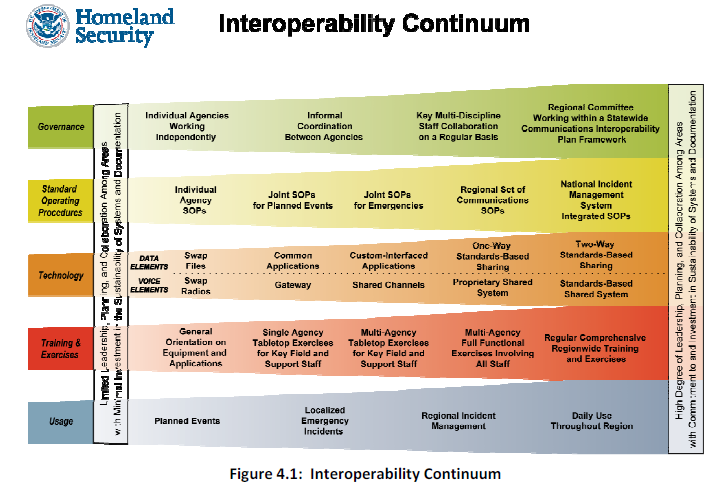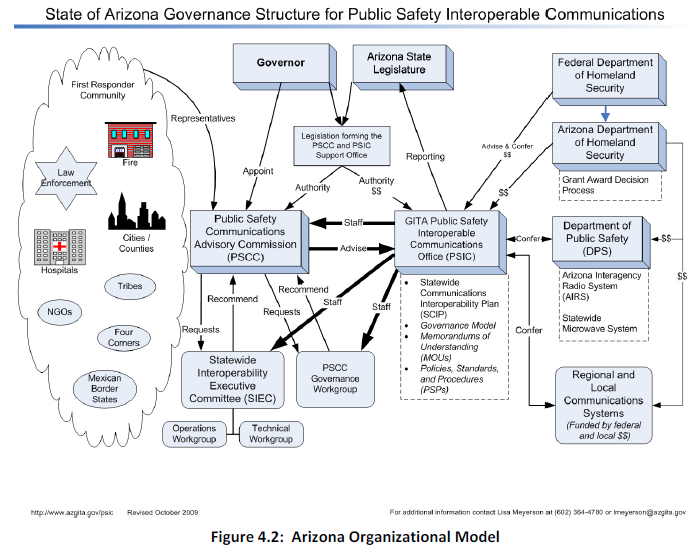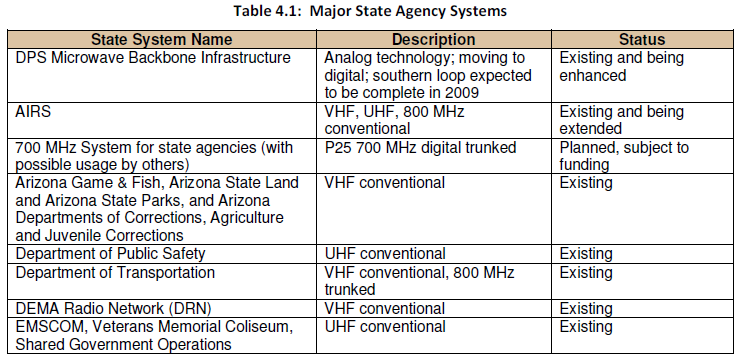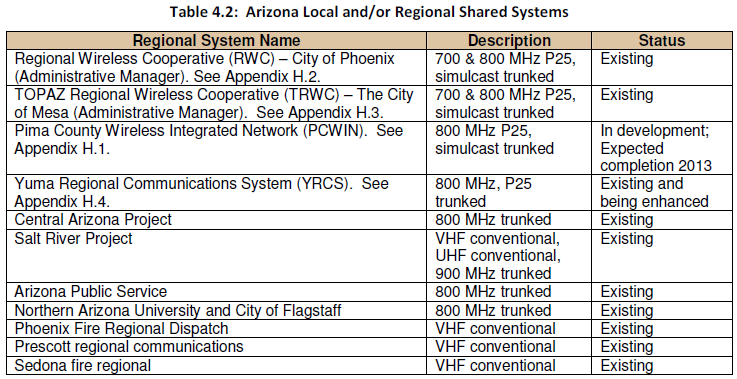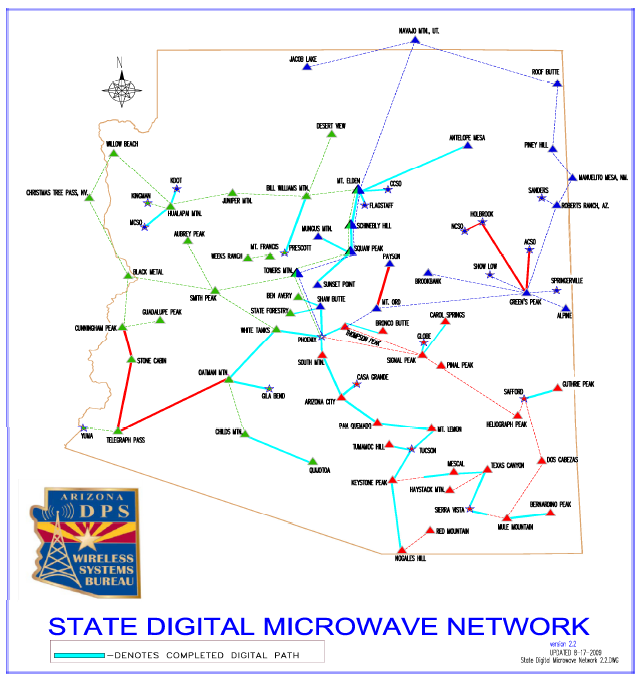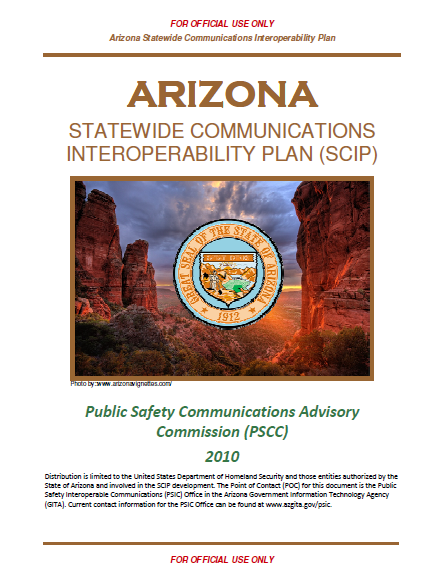 Public Safety Communications Advisory Commission (PSCC)
Public Safety Communications Advisory Commission (PSCC)
- 134 pages
- For Official Use Only
- February 2010
The Arizona Statewide Communications Interoperability Plan (SCIP) serves as a reference for public safety officials by describing the status of interoperable communications throughout Arizona and by documenting the specific goals and objectives Arizona has established to improve public safety communications.
Arizona developed the initial version of the SCIP in 2007, beginning with a high-level plan introduced at a Statewide Interoperability Executive Committee (SIEC) meeting in July 2007. After a series of meetings and forums, this SCIP was approved by the Public Safety Communications Advisory Commission (PSCC) in an open meeting on November 28, 2007. In July 2008, oversight of the PSCC transitioned to the Public Safety Interoperable Communications (PSIC) Office of the Arizona Government Information Technology Agency (GITA). The PSIC Office identified the need to update the SCIP in order to address known gaps in the Plan and to document updated approaches to tackling statewide strategic communications initiatives. This updated version of the SCIP was approved by the PSCC in an open meeting on January 19, 2010.
The PSCC, SIEC, and this Plan encourage local participation integral to Arizona’s strategic
planning efforts in support of interoperable communications. This SCIP addresses the shortand
long-term goals of the PSCC and SIEC, and contains the defined and actionable strategies
required to implement the vision of interoperability that public safety and service
agencies/organizations need in order to protect and serve the citizens of Arizona. The SCIP is
divided into five sections:1. Introduction – Introduces and defines the purpose of the Plan.
2. Background – Provides an overview of Arizona and its regions to set the context for
the rest of the Plan. This overview includes summaries of major geographic,
demographic, and infrastructure elements that impact interoperable communications
across Arizona. The overview also describes Arizona’s regional entities, including
counties, tribes, Arizona Department of Homeland Security (AZDOHS) Homeland
Security Regions, Urban Area Security Initiative (UASI) areas, and police, fire, and
Emergency Medical Service (EMS) associations.3. Methodology – Outlines the participatory methodology used to develop the SCIP.
Cross-jurisdictional and cross-disciplinary involvement in the development and
maintenance of this SCIP is achieved via several mechanisms:a. The PSCC and SIEC hold regular public meetings and workshops to discuss
and make recommendations for advancing statewide communications
interoperability.b. Standing workgroups of the PSCC and SIEC are tasked to address
interoperability issues in detail.c. The PSIC Office supports all of these groups and receives recommendations
from them regarding work plans related to the development of systems and
strategies for providing interoperability for public safety communications.d. The PSIC Office meets regularly with its State agency partners and also
supports a statewide Outreach Program providing regular and effective dialogue
with Arizona public safety and service agencies/organizations.4. Current Statewide Assessment — In recent years, Arizona has commissioned and
executed several studies to ascertain and document the current status of public safety
communications statewide. These studies recognize successful endeavors that could
be leveraged moving forward, and identify gaps hindering interoperability that need to
be mitigated or rectified through future initiatives and planning efforts. This section
synopsizes key findings from these assessments to describe the current status of
Arizona’s interoperable communications capabilities. Summaries of key findings are
divided into five categories:a. Governance – the relationship of the various bodies in the interoperable
communications governance structure, including the PSCC, SIEC, and the PSIC
Office. Applicable Memorandums of Understanding (MOUs) and Memorandums
of Agreement (MOAs) are described.b. Standard Operating Procedures (SOPs) – the process for developing statewide
SOPs, requirements for National Incident Management System (NIMS)
compliance, and identifying current SOPs for interoperable communications.c. Technology – a summary of the shared systems currently in operation in
Arizona, shared channels that are available for public safety use, and gateways
and radio caches in Arizona available to enhance interoperability.d. Training & Exercises – guidelines for Arizona’s training and exercise
opportunities, including Communications Unit Leader (COML) training
curriculum and credentialing procedures.e. Usage – information regarding the use of interoperable communications within
Arizona generally assessed at a jurisdictional level rather than as an overarching
statewide process.5. Strategy – lays out Arizona’s strategy, both short-term and long-term, for improving
interoperable communications by leveraging existing assets, agreements, and funding
sources. Funding sources are identified, grant management guidelines are defined,
and vision and mission statements for improving interoperability are introduced.
Arizona’s interoperability goals and objectives are defined, and linked to twelve strategic
initiatives.The SCIP is one of several coordinated blueprint planning efforts which provide the opportunity
for all levels of government to come together and consolidate information regarding their
communications needs, based on risk-benefit models projecting evolving future requirements.
This Plan provides a mechanism for governments to identify shared issues and assess future
common needs. Enhanced versions of this Plan look to include new objectives and possibilities
for the future.…
2.1.5 Critical Infrastructure
Arizona’s critical infrastructure includes highways, bridges, international ports of entry,
waterways, electric power plants (including nuclear facilities), airports, and telecommunications
sites. Each of these are critical to supporting Arizona’s standard of living and primary sources
of income which include tourism, high-tech industries, defense industries, a rising number of
retirement communities around the state, and the banking/finance sector.The 389 mile long border with Mexico includes six international crossing stations located at
Nogales-Mariposa, Douglas, Lukeville, Naco, Sasabe and San Luis. Nogales-Mariposa alone
sees almost $19 billion in trade annually representing 89% of all surface mode trade between
Arizona and Mexico.Arizona has over 400 dams. Two federally-operated dams, Hoover Dam and Glen Canyon
Dam are particularly noteworthy because each impacts the water supply and hydroelectric
production of multi-state areas. Major reservoir storage systems are located on the Colorado,
Salt, Verde, Gila, and Agua Fria Rivers. The Central Arizona Project is a 336-mile long system
of aqueducts, tunnels, pumping plants and pipelines and is the largest single source of
renewable water supplies in Arizona.Arizona is also home to the largest nuclear power generation facility in the United States. The
Palo Verde Nuclear Generating Station located about 55 miles west of central Phoenix has
three units capable of generating nearly 4,000 megawatts of electricity.…

